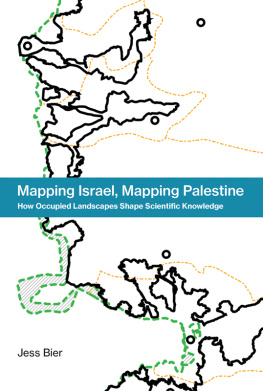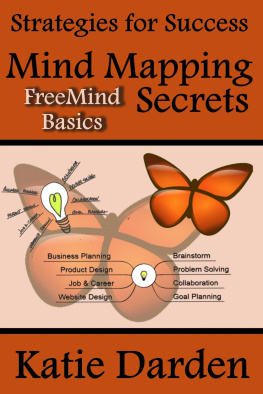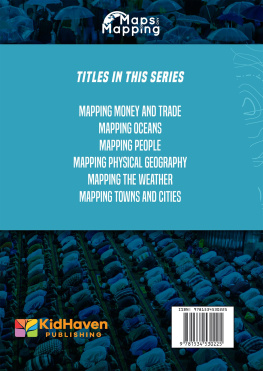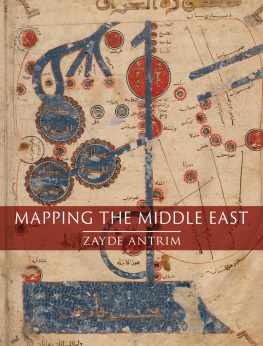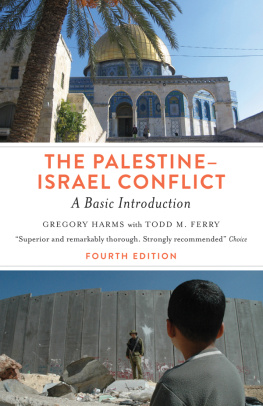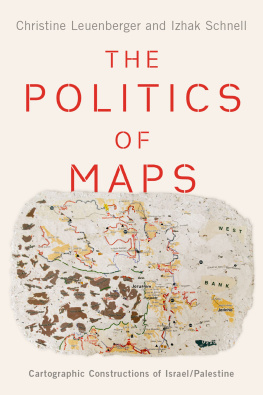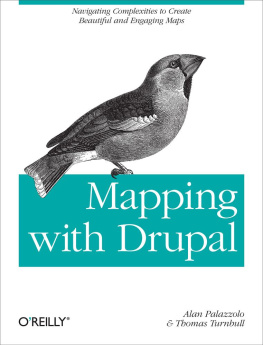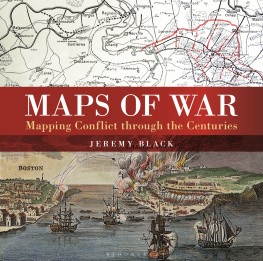

Inside Technology
edited by Wiebe E. Bijker, W. Bernard Carlson, and Trevor Pinch
A series list appears at the back of the book.
Mapping Israel, Mapping Palestine
How Occupied Landscapes Shape Scientific Knowledge
Jess Bier
The MIT Press
Cambridge, Massachusetts
London, England
2017 Massachusetts Institute of Technology
All rights reserved. No part of this book may be reproduced in any form by any electronic or mechanical means (including photocopying, recording, or information storage and retrieval) without permission in writing from the publisher.
This book was set in ITC Stone Sans Std and ITC Stone Serif Std by Toppan Best-set Premedia Limited. Printed and bound in the United States of America.
Library of Congress Cataloging-in-Publication Data
Names: Bier, Jess, 1980- author.
Title: Mapping Israel, mapping Palestine : how occupied landscapes shape
scientific knowledge / Jess Bier.
Description: Cambridge, MA : The MIT Press, [2017] | Series: Inside
technology | Includes bibliographical references and index.
Identifiers: LCCN 2016039117 | ISBN 9780262036153 (hardcover : alk. paper)
eISBN 9780262339940
Subjects: LCSH: Cartography--Political aspects--Israel. |
Cartography--Political aspects--West Bank. | Cartography--Political
aspects--Gaza Strip. | Land settlement--West Bank--Maps. | National
security--Israel--Maps. | Arab-Israeli conflict--Influence. | Map reading.
Classification: LCC GA1323.7.A1 B54 2017 | DDC 526.095694--dc23 LC record available at https://lccn.loc.gov/2016039117
ePub Version 1.0
In memory of Oliver Milton Bier
Acknowledgments
I began this book by redefining my geographic boundaries to include Maastricht. My dissertation advisers, Sally Wyatt and Bas van Heur, were incredibly supportive from the start, and I am infinitely thankful for their critical guidance and friendship. They were joined by my former colleagues in the technology and society department at Maastricht University (MUSTS), many of whom read chapters from this book in draft form. Matthijs Kouw has provided invaluable encouragement, as have numerous other colleagues and friends who have greatly enriched my time, including Jos Cornips, Birgit Bertram, Lonneke Theelen, Gili Yaron, Alexandra Supper, Koen Beumer, Eefje Cleophas, Anna Harris, Thomas Fuller, Jessica Mesman, and Veronica Davidov. The Netherlands Graduate Research School of Science, Technology, and Modern Culture (WTMC) offered a welcome space for further discussion with colleagues and mentors, including Teun Zuiderent-Jerak, Willem Halffman, Huub Dijstelbloem, Geoffrey Bowker, Helen Verran, and so many others. Maastricht University and the WTMC also graciously supplied the funding for this research.
My fieldwork was made possible through the generosity of many in Palestine and Israel who shared their time and expertise. Jaad Isaac and the colleagues of the Applied Research InstituteJerusalem (ARIJ) provided vital assistance and gracious hospitality. Riham Dweib answered endless questions and made me feel incredibly welcome. Ayman Abuzahra did so as well, and graciously has allowed me to use a photograph of him to illustrate the work done at ARIJ. Many were equally welcoming, including Ahmad, Issa, Sari, Ayman, Laila, Raed, and Suhail as well as Stefan Ziegler and the staff of the Border Monitoring Unit (BMU) at the United Nations Relief and Works Agency for Palestine Refugees in the Near East (UNRWA). Numerous cartographers and geographic information science (GIS) specialists explained their work to me with great patience. Some of them guided me back and forth across hills, checkpoints, walls, and innumerable bordersRiham in minibuses, Hagit Ofran in her truck, and Sahar and Rotem on foot, not to mention in taxis as well as on scooters and bicycles, but never a Segway. Lilach, Lika, Tammy, Taina, Shelby, Zuzanna, Fanny, Dan, Katie, and Blake sent regular invitations and welcomed me into their homes.
This book is much improved through the painstaking support of my editor, Katie Helke, and the editors of the Inside Technology series, Wiebe E. Bijker, W. Bernard Carlson, and Trevor Pinch; the thoughtful comments of the anonymous reviewers at MIT and beyond; and the efforts of my dissertation committee at Maastricht University. In my current position as an assistant professor of urban sociology at Erasmus University Rotterdam, I have the privilege of continuing to work on the key concerns that motivate this book, albeit on new topics. Willem Schinkel is truly inspiring both as a mentor and friend, as are Sanne Boersma, Rogier van Reekum, Maja Hertoghs, Irene van Oorschot, Friso van Houdt, Anne Slootweg, and Eva van Gemert. Bethany Hipple Walters, with the help of Carey, makes life in Rotterdam so much better with her kindness and friendship. Pamela Malpas provided irreplaceable and careful guidance that made the book possible in its present form. Miriyam Aouragh, Charles van den Heuvel, Thomas Pablo Sciarone, and Wytske Versteeg each contributed their thorough attention.
A number of scholars took time to talk and drink coffee or tea with me, even when I could offer nothing but questions and more questions, including Khalil Tufakji, Anat Leibler, Dov Gavish, Oren Yiftachel, Chris Parker, Omar Salamanca, Khaldun Bshara, Chen Misgav, Orit Halpern, Elena Glasberg, Ihab Saloul, Kristn Loftsdttir, Irna van der Molen, Shelby Carpenter, and Sofia Stamatopoulou-Robbins. Christine Leuenberger assisted greatly with fieldwork and generously ensured that this research got off to a rapid start. Faculty members at Birzeit University and Tel Aviv University also spoke with me at length about their work. With Rihams help at Birzeit, they also saved a place for me in the bus for field workshops and graduate seminars. The organizers of many conferences offered valuable comments, including those of the Postcolonial Europe Network conference: Postcolonial Transitions in Europe, along with Ulrich Best, Noam Leshem, Alisdair Pinkerton, Noura Alkhalili, Salvatore Paolo de Rosa, and Anders Lund Hansen. Staff members at numerous archives were invaluable, helping in the name of research even when they were not entirely sure what the product would be. They include the directors of the ARIJ Library, Oded Fluss at the National Library of Israel, Dora Druskin and the employees of the Tel Aviv University Map Library, Hana Pinshow at the Ben Gurion Research Institute, and the members of the GIS Unit at the Israeli Central Bureau of Statistics (CBS).
These concerns have been with me for the better part of my life. Academically, this project began when I studied at the American University in Cairo in fall 2000. It took root during my time at the City University of New York Graduate Center, where I also worked as a freelance GIS specialist. Marianna Pavlovskaya was instrumental in my development as a writer, as were Cindi Katz, Joseph Massad, William Tutol, Elinore Pedro, and Sean Tanner. Many others were generous in ways that ultimately benefited this book whether they knew it or not. They include Gamil Youssef, Anne Meneley, Mark Monmonier, and Sarah Gualtieri. Neil Smith and Michael W. Suleiman passed away too soon, and they are greatly missed. Those named here may or may not endorse the final book or its arguments, but I am truly thankful for their help.
When I was a child, my parents never refused to buy me a book and often went to great lengths to find specific ones that I requested, with my mother combing the stacks at local libraries, and my father scouring bookstores during his travels. This book wouldnt exist without their tremendous support and encouragement. Ben and Ethan, Rachel, Lucas, Carter, Natalie, Declan, and Charlotte force me to put down my laptop now and then, and I wouldnt want it any other way. Our boisterous and ever-growing extended family in California and New Jersey made sure I got into enough trouble to keep things interesting, but never too much that it wasnt possible to get out of it again. Im always really happy to see them.
Next page
